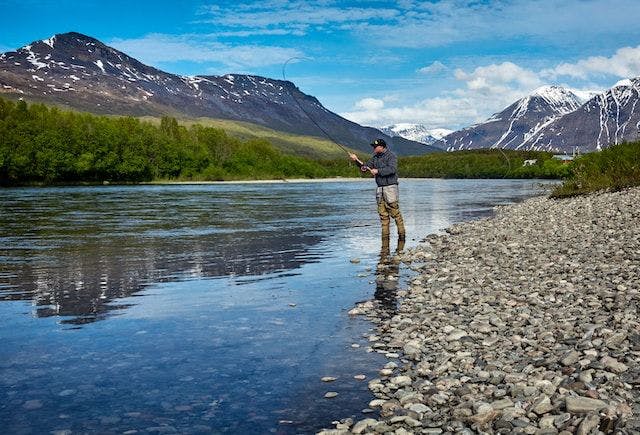Fishing is an enjoyable and relaxing activity that allows individuals to connect with nature and experience the thrill of reeling in a catch. However, like any outdoor pursuit, fishing comes with its own set of risks and hazards.
That’s why it’s crucial to prioritize safety on your fishing trips or team up with Galveston fishing charters for professional guidance. Meanwhile, this guide to fishing safety equipment will explore essential points to ensure your well-being on the water.
Personal Flotation Devices (PFDs)
One of the most critical pieces of fishing safety equipment is a Personal Flotation Device, commonly known as a PFD or life jacket. Whether you’re fishing from a boat, kayak, or the shoreline, wearing a PFD can save your life in case of an accident or unexpected event.
Choose a PFD that fits you well and is U.S. Coast Guard-approved. Ensure that all members of your fishing party wear their PFDs at all times while on or near the water.
Fly fishing flies are the angler’s artistic arsenal, finely crafted imitations that work like magic, beckoning fish from beneath the water’s surface.
First Aid Kit
Accidents can happen at any time, and being prepared with a well-stocked first aid kit is essential. A basic first aid kit for fishing should include adhesive bandages, sterile gauze pads, antiseptic wipes, adhesive tape, tweezers, scissors, pain relievers, and any necessary prescription medications.
Additionally, consider including items specific to fishing, such as hook removers and small packets of sunscreen to protect yourself from the sun’s harmful rays.
Explore the advanced features and capabilities of the Lowrance HDS 12 to elevate your marine navigation and fishing experience.
Communication Devices
Reliable communication devices are essential for fishing safety, especially when venturing into remote or unfamiliar waters. Carry a fully charged mobile phone in a waterproof case or a dedicated marine radio. These devices will allow you to call for help in case of an emergency or to stay in touch with fellow anglers.
Remember to store emergency contact numbers in your phone or radio and inform someone on land about your fishing plans and expected return time.
Lighting and Signaling Equipment
When fishing during low-light conditions or at night, having proper lighting and signaling equipment is essential for visibility and safety. Carry a waterproof flashlight with extra batteries to navigate your surroundings and to signal for help if needed.
In addition, consider carrying a whistle or an air horn, which can be used to alert nearby boats or individuals in case of an emergency. These signaling devices can greatly assist in attracting attention and getting the necessary help.
Weather Monitoring Tools
Weather conditions can change rapidly, and awareness of current and upcoming weather patterns is a fishing safety must. Invest in a reliable weather monitoring tool, such as a portable weather radio or a smartphone app, to keep track of local weather forecasts and severe weather alerts.
Pay attention to wind speed and direction, rainfall, thunderstorm potential, and any other relevant weather information. If adverse weather conditions are predicted, consider rescheduling your fishing trip or moving to a safer location.
Sun Protection
Spending extended periods outdoors while fishing exposes you to the sun’s harmful ultraviolet (UV) rays. Protecting yourself from sunburn and long-term skin damage is crucial. Wear a wide-brimmed hat or a cap to shield your face and neck from direct sunlight.
Apply a broad-spectrum sunscreen with a high SPF rating to all exposed skin, including your arms and legs. Remember to reapply sunscreen regularly, especially after sweating or being in the water. Consider wearing UV-protective clothing or long-sleeved shirts and pants for added sun protection.
Footwear and Traction
Fishing often involves navigating various terrains, such as slippery boat decks, rocky shorelines, or muddy riverbanks. Appropriate footwear with good traction helps prevent slips, falls, or twisted ankles. Choose shoes or boots with non-slip soles that offer stability on wet surfaces.
Avoid wearing open-toed sandals or flip-flops, as they provide minimal protection and can increase the risk of injury. Additionally, consider investing in cleats or traction devices that can be attached to your footwear for added grip on slippery surfaces.
Emergency Signaling Devices
In extreme situations where traditional forms of communication are not possible, emergency signaling devices can make a significant difference. Include signaling tools like a signal mirror, a whistle, or flares in your fishing safety kit.
Signal mirrors can help catch the attention of nearby vessels or search and rescue teams by reflecting sunlight. Whistles can be heard over long distances and are effective in attracting attention. Flares can indicate distress and are especially useful in low-light conditions. Familiarize yourself with the proper use of these devices to ensure you can effectively communicate your need for help if needed.
Equip Yourself for Fishing Success and Fun
With these precautions, you can fully embrace the wonders of fishing while keeping yourself and others safe. So gear up, head out, and enjoy the adventure of fishing with peace of mind!


Comments are closed.